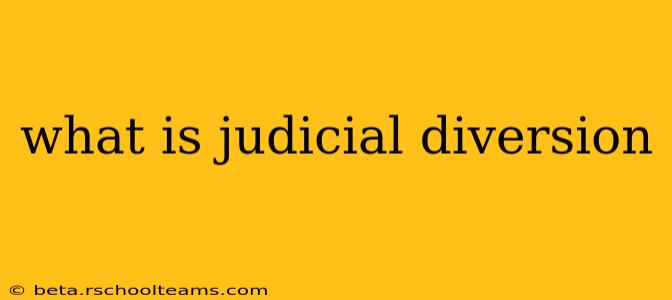Judicial diversion, also known as pretrial diversion or court diversion, is a process where individuals facing criminal charges are offered an alternative to traditional prosecution. Instead of going through a full trial, defendants participate in a program designed to address the underlying causes of their offense and rehabilitate them. This approach aims to reduce the burden on the court system, improve public safety, and promote offender rehabilitation. This guide explores the nuances of judicial diversion programs, their benefits and drawbacks, and eligibility criteria.
How Judicial Diversion Works
The process generally begins before a defendant pleads guilty or is found guilty. A prosecutor or judge may offer diversion as an option if certain criteria are met. These criteria vary depending on the jurisdiction, the specific offense, and the defendant's background.
Once accepted into a diversion program, defendants typically agree to specific conditions, which may include:
- Substance abuse treatment: For offenses related to drug or alcohol use.
- Mental health treatment: Addressing underlying mental health conditions contributing to the crime.
- Community service: Giving back to the community through unpaid work.
- Restitution: Repaying victims for financial losses incurred.
- Educational programs: Attending classes or workshops to address specific issues like anger management or financial literacy.
- Regular check-ins: Meeting with a probation officer or program supervisor.
Successful completion of the diversion program usually leads to the dismissal of the charges. However, failure to comply with the program's conditions can result in the original charges being reinstated and the defendant facing prosecution.
Types of Judicial Diversion Programs
Diversion programs are diverse and can cater to specific needs:
- Drug Court: Focuses on addressing substance abuse issues.
- Mental Health Court: Designed for individuals with mental health disorders.
- Veterans Court: Specifically targets veterans facing legal challenges.
- Domestic Violence Court: Addresses cases involving domestic violence.
- First-Offender Programs: Offered to individuals with no prior criminal record.
The specific requirements and structure of each program vary significantly depending on the jurisdiction and the nature of the offense.
Benefits of Judicial Diversion
Judicial diversion offers several advantages for both the defendant and the wider community:
- Reduced prison overcrowding: Diversion programs keep individuals out of jail, alleviating strain on the prison system.
- Cost savings: Diversion is generally cheaper than prosecution and incarceration.
- Improved public safety: Addressing the root causes of criminal behavior can reduce recidivism.
- Increased rehabilitation: Focuses on rehabilitation rather than punishment, leading to better long-term outcomes.
- Reduced stigma: Avoiding a criminal record can prevent future employment or housing issues.
- Faster resolution: Diversion programs often offer a quicker resolution than traditional court proceedings.
Drawbacks of Judicial Diversion
While judicial diversion provides many benefits, potential drawbacks should be considered:
- Eligibility restrictions: Not all defendants are eligible for diversion programs.
- Program availability: Access to programs can be limited depending on location and resources.
- Intensive requirements: Participation requires significant commitment and effort.
- Potential for failure: Failure to comply with program requirements can have severe consequences.
- Questionable effectiveness in certain cases: The effectiveness of diversion may vary depending on the type of offense and the individual's circumstances.
Eligibility Criteria for Judicial Diversion
Eligibility for judicial diversion is highly dependent on specific factors, including:
- The nature of the offense: Certain serious crimes might not be eligible for diversion.
- The defendant's criminal history: Prior convictions might disqualify a defendant.
- The defendant's willingness to participate: Active cooperation and commitment are crucial.
- Available resources: The availability of appropriate diversion programs in the area.
It's essential to consult with a legal professional to determine eligibility for a specific judicial diversion program.
Conclusion: A Valuable Tool in the Justice System
Judicial diversion presents a significant shift in the approach to criminal justice, prioritizing rehabilitation and community safety. While not a one-size-fits-all solution, it serves as a powerful tool for addressing the root causes of crime and improving the lives of both offenders and the community. Understanding its intricacies is crucial for navigating the legal system and utilizing its potential for positive change.
